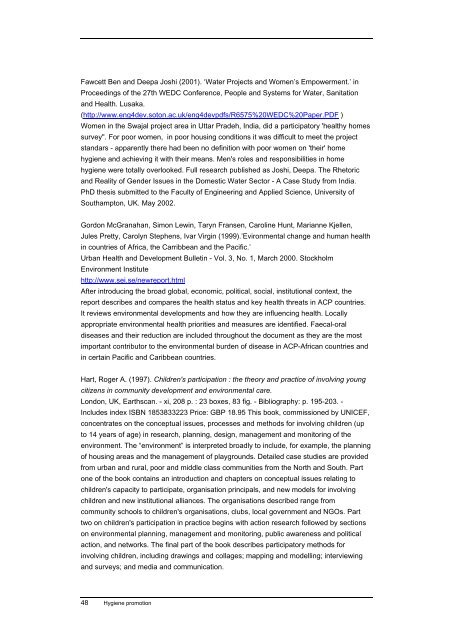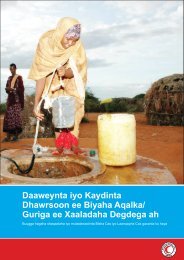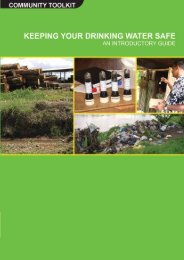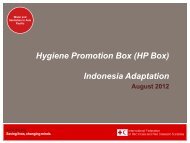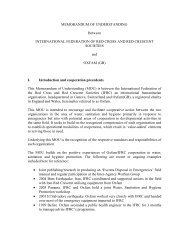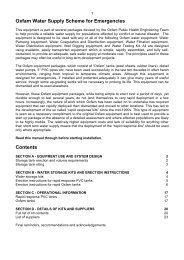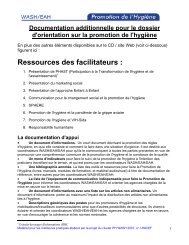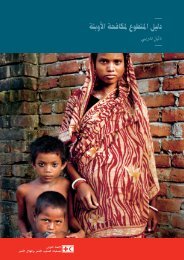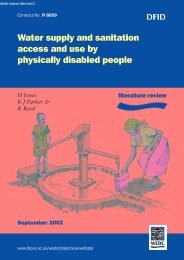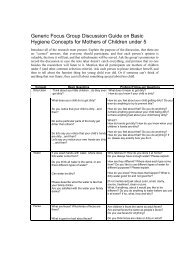Hygiene Promotion - IRC International Water and Sanitation Centre
Hygiene Promotion - IRC International Water and Sanitation Centre
Hygiene Promotion - IRC International Water and Sanitation Centre
Create successful ePaper yourself
Turn your PDF publications into a flip-book with our unique Google optimized e-Paper software.
Fawcett Ben <strong>and</strong> Deepa Joshi (2001). ‘<strong>Water</strong> Projects <strong>and</strong> Women’s Empowerment.’ inProceedings of the 27th WEDC Conference, People <strong>and</strong> Systems for <strong>Water</strong>, <strong>Sanitation</strong><strong>and</strong> Health. Lusaka.(http://www.eng4dev.soton.ac.uk/eng4devpdfs/R6575%20WEDC%20Paper.PDF )Women in the Swajal project area in Uttar Pradeh, India, did a participatory 'healthy homessurvey". For poor women, in poor housing conditions it was difficult to meet the projectst<strong>and</strong>ars - apparently there had been no definition with poor women on 'their' homehygiene <strong>and</strong> achieving it with their means. Men's roles <strong>and</strong> responsibilities in homehygiene were totally overlooked. Full research published as Joshi, Deepa. The Rhetoric<strong>and</strong> Reality of Gender Issues in the Domestic <strong>Water</strong> Sector - A Case Study from India.PhD thesis submitted to the Faculty of Engineering <strong>and</strong> Applied Science, University ofSouthampton, UK. May 2002.Gordon McGranahan, Simon Lewin, Taryn Fransen, Caroline Hunt, Marianne Kjellen,Jules Pretty, Carolyn Stephens, Ivar Virgin (1999).’Evironmental change <strong>and</strong> human healthin countries of Africa, the Carribbean <strong>and</strong> the Pacific.’Urban Health <strong>and</strong> Development Bulletin - Vol. 3, No. 1, March 2000. StockholmEnvironment Institutehttp://www.sei.se/newreport.htmlAfter introducing the broad global, economic, political, social, institutional context, thereport describes <strong>and</strong> compares the health status <strong>and</strong> key health threats in ACP countries.It reviews environmental developments <strong>and</strong> how they are influencing health. Locallyappropriate environmental health priorities <strong>and</strong> measures are identified. Faecal-oraldiseases <strong>and</strong> their reduction are included throughout the document as they are the mostimportant contributor to the environmental burden of disease in ACP-African countries <strong>and</strong>in certain Pacific <strong>and</strong> Caribbean countries.Hart, Roger A. (1997). Children's participation : the theory <strong>and</strong> practice of involving youngcitizens in community development <strong>and</strong> environmental care.London, UK, Earthscan. - xi, 208 p. : 23 boxes, 83 fig. - Bibliography: p. 195-203. -Includes index ISBN 1853833223 Price: GBP 18.95 This book, commissioned by UNICEF,concentrates on the conceptual issues, processes <strong>and</strong> methods for involving children (upto 14 years of age) in research, planning, design, management <strong>and</strong> monitoring of theenvironment. The “environment” is interpreted broadly to include, for example, the planningof housing areas <strong>and</strong> the management of playgrounds. Detailed case studies are providedfrom urban <strong>and</strong> rural, poor <strong>and</strong> middle class communities from the North <strong>and</strong> South. Partone of the book contains an introduction <strong>and</strong> chapters on conceptual issues relating tochildren's capacity to participate, organisation principals, <strong>and</strong> new models for involvingchildren <strong>and</strong> new institutional alliances. The organisations described range fromcommunity schools to children's organisations, clubs, local government <strong>and</strong> NGOs. Parttwo on children's participation in practice begins with action research followed by sectionson environmental planning, management <strong>and</strong> monitoring, public awareness <strong>and</strong> politicalaction, <strong>and</strong> networks. The final part of the book describes participatory methods forinvolving children, including drawings <strong>and</strong> collages; mapping <strong>and</strong> modelling; interviewing<strong>and</strong> surveys; <strong>and</strong> media <strong>and</strong> communication.48 <strong>Hygiene</strong> promotion


